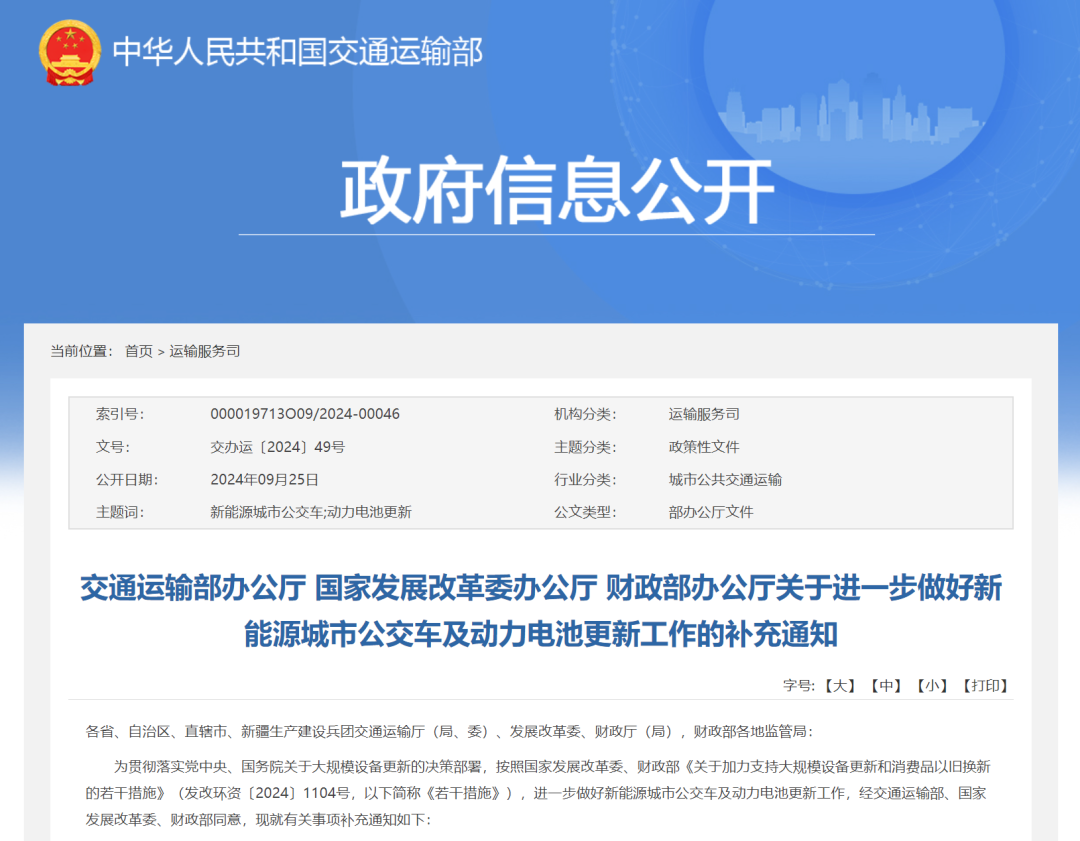In relation to the renewal of new energy buses and batteries, the Ministry of Transport issues another document
![]() 09/27 2024
09/27 2024
![]() 391
391

After the subsidy standards and funding sources have been clarified previously, on September 24, the Ministry of Transport, the National Development and Reform Commission, and the Ministry of Finance jointly issued the "Supplementary Notice on Further Improving the Renewal of New Energy City Buses and Power Batteries." Through clear subsidy standards, supported vehicle types, applicant conditions, and detailed operational procedures, comprehensive guidance and support are provided for the renewal of new energy city buses and power batteries. Additionally, several items were not previously clearly mentioned, including that the subsidy amount for replacing power batteries must not exceed 50% of the price of newly purchased power batteries, that the old buses that can be scrapped are no longer limited to new energy vehicles, that the replacement of low-floor, low-entry new energy city buses is encouraged, and specific requirements for the scrapping and renewal of finance-leased vehicles or battery replacement.
1. Subsidy Standards and Procedures: Subsidy Standards:
The average subsidy for each renewed new energy city bus is 80,000 yuan, and the subsidy for each replaced power battery is 42,000 yuan, with the subsidy amount not exceeding 50% of the price of the newly purchased power battery. Subsidy Procedures: The local transportation authorities review and summarize subsidy applications, determine the subsidy amount, and apply for funds from the finance department at the same level. After reviewing, the finance department disburses the subsidy funds, and the provincial finance department summarizes the fund disbursement and reports it to the local supervision bureau of the Ministry of Finance.
2. Supported Vehicle Types for Subsidies:
Scrapping Principles: Prioritize the scrapping of old new energy city buses, but other fuel-type buses can also be scrapped based on funding needs. New Purchase Requirements: New city buses must be new energy vehicles, including pure electric, plug-in hybrid, and hydrogen fuel cell vehicles, and must be used for "public passenger transport." Encouraged Direction: Encourage the replacement of low-floor and low-entry new energy city buses to stabilize price levels.
3. Applicant Conditions:
Qualification Requirements: Applicants must legally obtain the right to operate urban bus routes and their name must match the owner listed in the vehicle registration certificate. Scrapping and Purchase: Old buses that are to be scrapped can be finance-leased vehicles, and a finance lease contract must be provided. For newly purchased new energy buses and power batteries, invoices and payment receipts must be provided.
4. Policy Background and Funding Sources:
Policy Background: Implement the decision-making deployment of the Party Central Committee and the State Council on large-scale equipment renewal and vigorously support the renewal of new energy buses and power batteries. Funding Sources: The National Development and Reform Commission directly allocates ultra-long-term special treasury bonds to local areas to support the renewal of new energy buses and power batteries.
5. Local Cooperation and Support: Local Support:
Encourage local areas to use urban transportation development incentive funds to support the renewal of new energy city buses and power batteries. After the issuance of the "Several Measures" and "Detailed Rules for Implementation," utilize ultra-long-term special treasury bonds to further support these efforts. Departmental Collaboration: Transportation authorities must collaborate with development and reform departments and finance departments to ensure reasonable funding arrangements and proper subsidy disbursement.
6. Supervision and Reporting: Supervision Requirements:
All levels of departments must strengthen supervision over subsidy funds to ensure that funds are used exclusively for their intended purpose and prevent abuse or misappropriation. Reporting System: Provincial finance departments must summarize fund disbursements and report them to the local supervision bureau of the Ministry of Finance to ensure transparency and traceability of fund usage.
7. Promoting Industry Development: Market Demand:
Stimulate market demand for new energy city buses and power batteries through subsidy policies, driving the development of related industrial chains. Energy Conservation and Emission Reduction: The widespread application of new energy buses helps reduce carbon emissions, improve urban air quality, and promote sustainable development.








